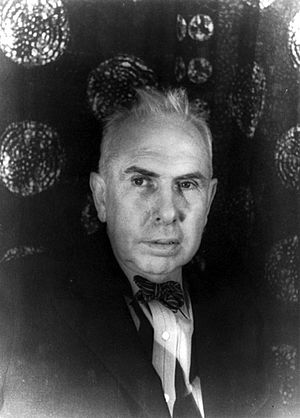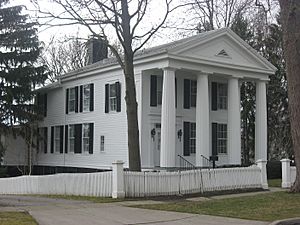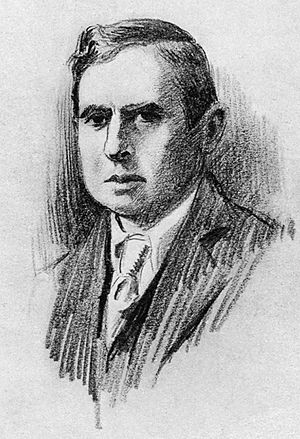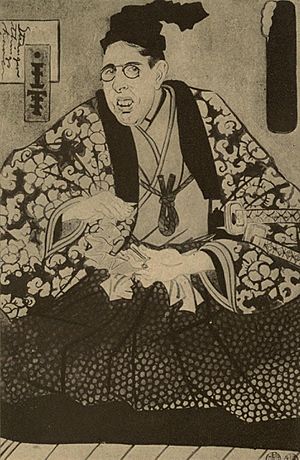Theodore Dreiser facts for kids
Quick facts for kids
Theodore Dreiser
|
|
|---|---|

Theodore Dreiser, photographed by Carl Van Vechten, 1933
|
|
| Born |
Theodore Herman Albert Dreiser
August 27, 1871 Terre Haute, Indiana, U.S.
|
| Died | December 28, 1945 (aged 74) Hollywood, California, U.S.
|
| Occupation | Novelist |
| Spouse(s) |
Sara Osborne White
(m. 1898; sep 1909)Helen Patges Richardson
(m. 1944) |
| Relatives | Paul Dresser (brother) |
Theodore Dreiser (born August 27, 1871 – died December 28, 1945) was an American writer and journalist. He was known for his realistic novels, which often showed characters trying to achieve their goals even when facing tough situations. His stories explored how people's lives were shaped by their surroundings. Two of his most famous novels are Sister Carrie (1900) and An American Tragedy (1925).
Contents
Early Life and Family
Theodore Dreiser was born in Terre Haute, Indiana. His father, John Paul Dreiser, was a German immigrant, and his mother, Sarah Maria, came from a Mennonite family. Sarah's family did not approve when she became Catholic to marry John. Theodore was one of thirteen children, and nine of them lived to adulthood. His older brother, Paul Dresser, became a well-known songwriter and changed the spelling of his last name. The family grew up following the Catholic faith.
Dreiser's childhood was often difficult, and his family faced poverty. These early experiences later influenced the stories he wrote. After finishing high school in Warsaw, Indiana, Dreiser attended Indiana University for a year in 1889–1890. He did not earn a degree there.
Starting a Career in Journalism
In 1892, Dreiser began working as a reporter and theater critic for newspapers. He worked in big cities like Chicago, Saint Louis, Toledo, Pittsburgh, and New York. During this time, he published his first short story, The Return of Genius, under the name Carl Dreiser.
By 1895, he started writing articles for magazines. He wrote about famous writers such as Nathaniel Hawthorne and interviewed important public figures. These included business leaders like Andrew Carnegie and Marshall Field, and inventors like Thomas Edison.
In 1895, Dreiser became the editor of a magazine called Ev'ry Month. He published his first story there, called "Forgotten." He continued to edit magazines, some of which were for women. This work helped him become financially independent.
Becoming a Novelist
In 1899, Dreiser started writing his first novel, Sister Carrie, while staying in Maumee, Ohio. The book was published in 1900.
In Sister Carrie, Dreiser wrote about a young woman who leaves her small town for the big city of Chicago. She struggles to find a good job and makes choices about relationships to achieve her dreams of fame and fortune as an actress. The book was considered controversial at the time because it showed a young woman making her own choices, which was new for the time. Even though it didn't sell well at first, it later became very famous. Many people now call it one of the "greatest of all American urban novels."
His second novel, Jennie Gerhardt, came out in 1911. Like Sister Carrie, it featured a young woman as the main character. These stories showed the big changes happening in society as young people moved from small towns to growing cities.
Dreiser's first major success came with An American Tragedy, published in 1925. He based this novel on a real-life murder case from 1906 that had been widely reported in newspapers. The novel sold very well, but some people criticized it for how it showed the main character's difficult choices.
Besides novels, Dreiser also wrote short stories. His first collection, Free and Other Stories, was published in 1918 and included 11 tales. One of his stories, "My Brother Paul," was about his older brother, Paul Dresser, the famous songwriter. This story later became the basis for the 1942 movie My Gal Sal.
Dreiser also wrote poetry. His poem "The Aspirant" (1929) explored themes of poverty and ambition. He also wrote a series of novels called Trilogy of Desire, which was based on the life of a Chicago streetcar businessman named Charles Yerkes. This series included The Financier (1912), The Titan (1914), and The Stoic, which was published after he died.
Dreiser often faced challenges because his realistic stories sometimes went against what was considered acceptable at the time. In 1930, he was nominated for the Nobel Prize in Literature, but another author, Sinclair Lewis, won that year.
Political Beliefs and Actions
Dreiser was interested in politics and often supported people he believed were treated unfairly. He spoke out in cases like the Sacco and Vanzetti trial and supported labor leaders. In 1931, he led a group to Kentucky to hear from miners who were facing violence from coal companies during the Harlan County War.
Dreiser was a socialist, meaning he believed in a system where society owns and controls the means of production. He wrote several nonfiction books about political topics. These included Dreiser Looks at Russia (1928), after his trip to the Soviet Union, and books that criticized capitalism in America, such as Tragic America (1931). He joined the Communist Party USA in 1945.
Personal Life
While working as a newspaper reporter in St. Louis, Dreiser met Sara Osborne White, a schoolteacher. They got engaged in 1893 and married on December 28, 1898. They separated in 1909 but never officially divorced.
Later, in 1919, Dreiser met his cousin Helen Patges Richardson. She became a very important person in his life. Helen stayed with Dreiser until he died, even though he had other relationships. After his first wife, Sara, passed away in 1942, Dreiser and Helen married on June 13, 1944.
Interestingly, Dreiser had planned to return from a trip to Europe on the famous ship Titanic. However, an English publisher convinced him to take a cheaper ship instead, which saved his life. Dreiser was an atheist, meaning he did not believe in God.
Legacy and Influence
Theodore Dreiser had a huge impact on the writers who came after him. His main focus was on the strong feelings and challenges that come from ambition, desires, and society's rules.
Two buildings are named after him:
- Dreiser Hall, built in 1950 at Indiana State University in Terre Haute, Indiana. It houses the university's communication programs and a theater.
- Dreiser College, at Stony Brook University in Stony Brook, New York.
In 2011, Dreiser was honored by being included in the Chicago Literary Hall of Fame.
Works
Fiction Books
- Sister Carrie (1900)
- Jennie Gerhardt (1911)
- The Financier (1912)
- The Titan (1914)
- The "Genius" (1915)
- Free and Other Stories (1918)
- An American Tragedy (1925)
- Chains: Lesser Novels and Stories (1927)
- The Total Stranger (around 1944)
- The Bulwark (1946)
- The Stoic (1947)
Plays
- Plays of the Natural and Supernatural (1916)
- The Hand of the Potter (1918)
Poetry Books
- Moods: Cadenced and Declaimed (1926)
Nonfiction Books
- A Traveler at Forty (1913)
- A Hoosier Holiday (1916)
- Twelve Men (1919)
- Hey Rub-a-Dub-Dub: A Book of the Mystery and Wonder and Terror of Life (1920)
- A Book About Myself (1922); also called Newspaper Days (1931)
- The Color of a Great City (1923)
- Dreiser Looks at Russia (1928)
- My City (1929)
- A Gallery of Women (1929)
- Tragic America (1931)
- Dawn (1931)
- America Is Worth Saving (1941)
See also
 In Spanish: Theodore Dreiser para niños
In Spanish: Theodore Dreiser para niños




